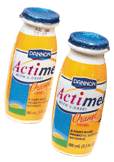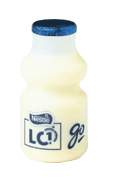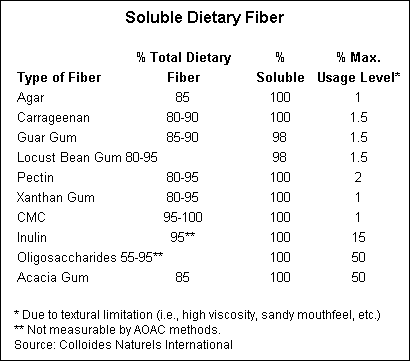
At the recent Health Ingredients Europe (HIE) conference and exhibition in Frankfurt, Germany, several presenters discussed the latest scientific research on both prebiotics and probiotics.
Prebiotic Tolerance
A former research manager with and now advisor to Colloides Naturels International, France, Thierry Kravtchenko presented recent research on "The Gastrointestinal Tolerance of Regular FiberGum (acacia gums) Intake in Healthy Individuals."FiberGum is water-soluble and contains more than 85% fiber via AOAC test methods. It promotes the production of large quantities of short-chain fatty acids, which are known to play several beneficial roles in the host physiology. In addition, FiberGum encourages the development of beneficial intestinal bacteria, such as lactobacillus and bifidobacteria.
The gastrointestinal tolerance study included 10 healthy subjects between 20 and 40 years of age with no history of gut disorders or medication.
Comprised of three phases, the study began with a "run-in" period of eight days in which the subjects consumed 10 g/day of sugar beet sucrose as control. This was followed by an 18-day experimental period whereby the subjects consumed gradually increasing daily doses--ranging from 10 g to 70 g--of sugar beet sucrose (control), fructo-oligosaccharides (FOS) for comparative purposes, or FiberGum. Each period was separated by a 15-day "wash-out" period.
In the final phase (one-day period), the subjects consumed a single dose of 20 g of each substrate. The frequency and severity of symptoms (i.e., flatulence, abdominal cramps, nausea, etc.) and fecal excretion were analyzed from data recorded by subjects in a daily diary.
In conclusion, neither FiberGum nor the FOS modified the frequency and volume of fecal excretion. However, FOS caused diarrhea in 20% of the subjects at a dose level of 10 g/day. FiberGum consumption induced no diarrhea, even at high dose (70 g) levels.
The acacia gum did not cause any more flatulence or bloating than the control at daily dose levels of less than 30 g. In contrast, FOS consumption caused flatulence in 80% of subjects and bloating in 40% of subjects at a dose level of 10 g/day.
In another study of 10 subjects, the consumption of 10 g/day of FiberGum significantly increased the fecal concentration of lactic acid bacteria and bifidobacteria. None of the other bacteria counted showed an increase in numbers, indicating a specific, bifidogenic effect from FiberGum.
Partially Hydrolyzed Guar Gum
Lekh Juneja, managing director--Nutritional Foods Division of Taiyo Kagaku Co., Japan, spoke on the "Physiological and Technical Functions of Hydrolyzed Guar Gum as Natural Water-Soluble Dietary Fiber."Tradenamed SunFiber, the water-soluble dietary fiber is produced by a controlled partial enzymatic hydrolysis of guar beans. Containing more than 80% dietary fiber via AOAC methods, the partially hydrolyzed guar gum (PHGG) does not influence the taste or viscosity (5 mPa's in a 5% solution at 5°C) of food and beverage products. PHGG has a low caloric value (0.2 kcal/g).
During periods of iron deficiency in rats, SunFiber has been shown to increase the absorption of the mineral. In a study of eight men over four weeks, the administering of 36 g/day of PHGG resulted in the lowering of both serum cholesterol and serum triglyceride.
The hydrolyzed guar gum also increases the levels of bifidobacteria and enhances the production of short-chain fatty acids in the human gut.

Fructo-oligosaccharides
At the HIE conference, Dr. Francis Bornet, M.D., Health & Nutrition Group, Eridania Beghin-Say, Belgium, spoke on "Short-Chain Fructo-oligosaccharides (scFOS) for Intestinal Benefits."Due to their nutritional properties, scFOS have aroused interest in the past decade. To a large extent, fructans escape digestion in the upper human intestine and reach the colon where they are totally fermented to mostly lactate, short chain fatty acids (acetate, propionate and butyrate), H2 and CO2.
scFOS stimulate bifidobacterial growth while suppressing the growth of other species, such as Clostridium perfingens in the colon. The prebiotic effect of fructans is dose-dependent and chain-length related. It is associated with a decrease of fecal pH, an increase of fecal or colonic organic acids, and a decrease in the production of nitrogenous end products (i.e., ammonia and amines) in urine and stools.
In animal models, scFOS reduced colon tumor development by enhancing both colon butyrate concentrations and local immune system factors.
Eridania Beghin-Say's Actilight soluble dietary fiber is made from sugar beets. Its short-chain fructo-oligosaccharides naturally feed the bifidobacteria living in the large intestine and promote their development.
Recent studies have shown that a dosage of 10 g/day of Actilight increases magnesium absorption by nearly 12%. As a contributor in numerous metabolic reactions, magnesium plays an essential role in bodily functions and is involved in the prevention of numerous diseases, such as cardiovascular and illnesses linked to aging. Neuro-muscular signs (latent tetany), fatigue, anxiety, palpitations and even stress are sometimes the result of magnesium deficiency.
In France, recent studies revealed that 77% of women and 72% of men eat less than the recommended daily intake (RDI) of magnesium. Furthermore, about 20% of the adult French population consume less than two-thirds of the RDI.
There is also some evidence that Actilight may increase calcium absorption.

Gut Health Communication
Paul Coussement, executive vice president of sales & marketing/regulatory affairs, Orafti Active Food Ingredients, Belgium, talked about "Communicating Gut Health to the Consumer: Presenting a New Communication Program."Orafti produces inulin from the extraction of chicory roots. From inulin, the company manufactures oligofructose and fructose by enzymatic hydrolysis. Both inulin products, trademarked Raftiline, and oligofructose products, trademarked Raftilose, are dietary fibers, which stimulate the bifidobacteria flora in the human colon.
Through research by Orafti, the products have been shown to increase calcium absorption and decrease serum triglycerides. Ongoing studies are examining the inhibition of cancer and improvement of the immune response.
Because of its experience in nutritional products and health claims, Orafti has provided advice to food companies on the marketing of functional foods and beverages. In communicating about the "health aspects" on food product labeling, the company believes that three basic criteria need to be followed.
First, the message should be simple--easy to understand, clear and direct. Second, the message should be positive. Consumers are more interested in the "positive" aspects of a food than in the "disease prevention" functions. Disease prevention products are probably going to end up as niche products. On the other hand, functional foods with a positive message have the potential to become real "family" products that consumers can enjoy at any time.
Lastly, the message should be science-based. However, this does not necessarily have to be on the packaging. Consumers are interested in the science, and will want to see evidence of it. Avoid terms, however, that they don't understand. Most importantly, the science should be solid, not science fiction.
To communicate the health benefits of its inulin and oligofructose ingredients in food and beverage products, Orafti has created the BENEO program.
The communication plan consists of four main elements. First, messages are clear, simple and positive. Second, the communication is consistent from different partners. Third, the message is based on science. Precise claims are backed up by solid research data in humans. And last, Orafti has created the BENEO symbol that can appear on all products and carriers of information that participate in the program. The symbol stands for the presence of the active ingredients in sufficient amounts to have the effects that are claimed on the package.
After establishing these general BENEO health message principles, Orafti conducted consumer research in Belgium to find out how to talk about gut health.
The research concluded that "gut flora" is not a taboo and exists in the mind of the consumer. In addition, it is logical and understandable for the consumer that a product can have a healthy effect on the bacteria in the gut. An ingredient that improves the gut flora is seen as a natural way of protecting your body and making it function in a better way. This ingredient offers the opportunity to do something for your health in a simple way.
Consumers are skeptical and critical of "scientists" or "professors", according to the research. Most consumers believe that opinions from these sources can be easily contradicted by other so-called experts.
The research also has identified which communication channels to use to get the BENEO message to consumers. In Belgium, Orafti is putting high emphasis on correct information to health professionals, dieticians, nutritionists and physicians.
With the BENEO symbol and communication program, Orafti is informing the consumer about the positive health aspects of inulin and oligofructose. This should ultimately lead to greater consumer awareness and understanding, which will create a "pull" effect on sales of products containing the BENEO ingredients.
Orafti rolled out the BENEO program--a two-year development process--in Belgium in 2000. The company expects to expand the program to other countries in and outside of Europe in 2001. Each program will be tailored for the locale.

Probiotic Progress
At the HIE conference, V. Krishnakamur, managing director, Giract, Switzerland, discussed "Probiotic Cultures: Revolution or Evolution?"Probiotics were first conceptualized by the Nobel Prize winning Russian scientist Elie Metchnikoff at the turn of the 20th century. He believed that the fermenting bacillus (now called Lactobacillus) contained in the fermented milk products consumed by Bulgarian peasants positively influenced the microflora of the colon and decreased toxic microbial activities.
The most recognized probiotic bacteria are Lactobacillus and bifidobacteria. Lactobacillus species include acidophilus, bulgaricus, lactis, plantarum, rhamnosus, reuteri, casei, paracasei, fermentum, and helvetus. Bifidobacteria species include adolescentis, longum, breve (Yakult), bifidus, essensis (Danone Bio Activia), lactis, infantis, lactosporus, and subtilis.
Probiotics are well accepted in Asia (especially Japan and Korea) as an effective prophylaxis against intestinal disorders. Many products are available, particularly in Japan, that claim to impart a positive effect on the digestive tract.
Probiotic foods and supplements are popular in Europe. The use of probiotics in foods, however, is largely restricted to the fermented milk sector. In the U.S., probiotics are found essentially in the supplements sector. Although they are used in most yogurts, the addition of the ingredient in this case is to achieve a mild taste.
To deliver a health benefit, the probiotic should be at a level of 106 to 107 cfu/g at the time of consumption. In Japan, Yakult has recently raised the bar by increasing the dosage to 2.3 x 108 in its standard product.
Clinical documentation has shown that specific strains of probiotics are very useful in the management of diarrhea. Probiotics may also play a role in cancer risk reduction, particularly colon cancer.
Other benefits commonly cited include cholesterol reduction, recolonization following antibiotics, reduction of irritable bowel syndrome, and reduced eczema--particularly in the case of children.
Although some evidence exists for these other probiotic-related benefits, further research needs to be carried out to establish credibility and achieve legislative approval in the Western world.

Ingredient Developments at Health Ingredients Europe
Following is a list of key functional ingredients that were either introduced or featured at the recent Health Ingredients Europe Exhibition in Germany.
Synbiotic for fermented dairy products consists of a range of starter cultures with probiotic properties and a high-amylose resistant starch with prebiotic properties.
DSM Food Specialties.
GM-alternative fruit powders and carrot freeze-dried vegetable powder add natural juice content and taste to confections, dry beverages, baked goods, functional foods and nutraceuticals.
Crystals International Inc.
Dietary fibers for functional foods include wheat fiber, oat fiber, apple fiber, orange fiber and tomato fiber. Applications include bakery, snack, potato fruit bar, meat and beverage products.
J. Rettenmaier.
Immunoglobulin concentrate maintains gastrointestinal health and immune system function. Whey protein concentrate delivers functional and nutritional attributes without affecting flavor.
Proliant.
A bio-nutritional database (FortiSource) for researching specific food ingredients is just one of the new features of a redesigned website (www.fortitech.com) for Fortitech.
Fortitech Inc.
Cranberries may help fight bacteria (H. pylori) that causes ulcers. New research suggests that the cranberry's bacterial anti-adhesion mechanism may be a new tool to fight ulcers and the bacteria that cause them.
Ocean Spray Cranberries.

Nutrinova.
Omega 3 long-chain polyunsaturated fatty acids can be used to fortify foods and beverages. Lutein and vitamin E acetate in both oil and dry forms have application in food supplements and nutritionals.
Roche Vitamins.
Lactitol is a non-absorbable disaccharide, which functions as a prebiotic. In the large intestine, it is fermented--producing short-chain fatty acids, lactate and gases. Lactitol should selectively stimulate beneficial bacteria in the colon.
Purac.
A health bar made with omega 3 fatty acids and a vitamin premix was demonstrated by BASF. Long-chain omega 3 polyunsaturated fatty acids from marine sources have been associated with the reduced risk of coronary heart disease.
BASF.